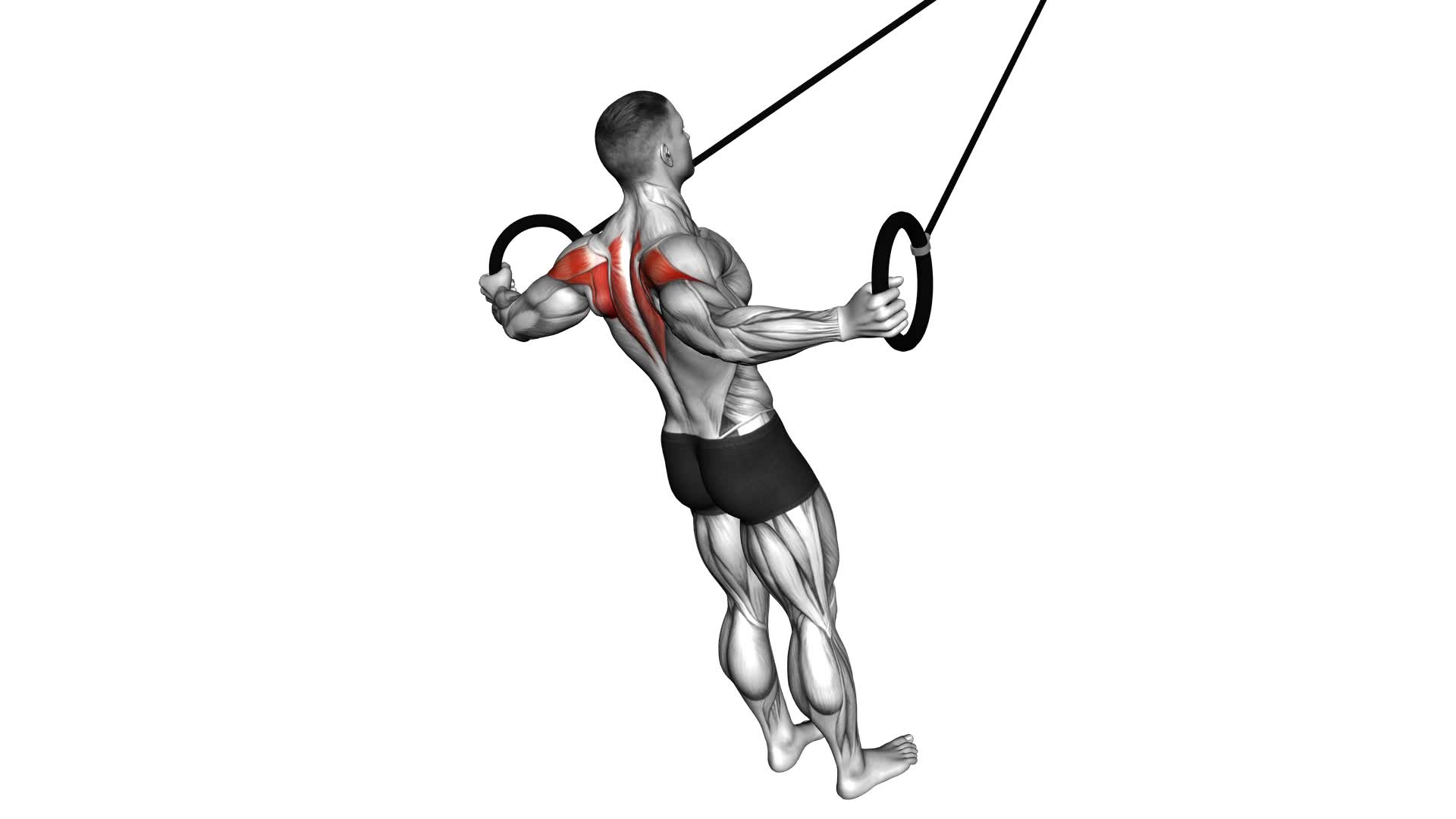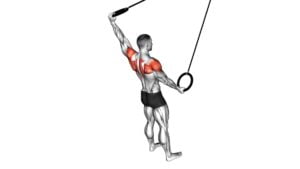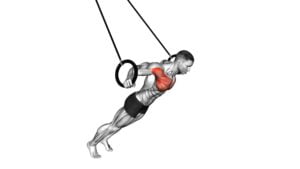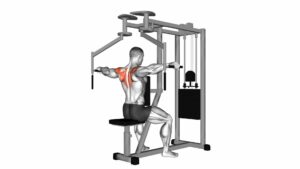Ring Reverse Fly – Video Exercise Guide & Tips

Are you looking for a new exercise to strengthen your upper body? Look no further than the Ring Reverse Fly!
Watch This Exercise Video
This video exercise guide will show you how to properly perform this move, targeting your shoulders and upper back.
With just a few simple tips, you can avoid common mistakes and maximize the benefits of this exercise.
Get ready to tone and sculpt your muscles with the Ring Reverse Fly!
Key Takeaways
- The Ring Reverse Fly targets the shoulders and upper back, improving shoulder mobility and strengthening rear deltoids, rhomboids, and traps.
- Proper form and technique are crucial, including engaging the core, squeezing the shoulder blades together, and controlling the movement.
- The exercise can be performed using rings or alternative equipment such as dumbbells, resistance bands, or cables.
- Common mistakes to avoid include using excessive momentum, hunching or rounding the back, and neglecting proper form and technique.
Benefits of the Ring Reverse Fly
You will experience numerous benefits from incorporating the Ring Reverse Fly into your workout routine. This exercise is a great addition to your strengthening exercises as it specifically targets your shoulders and improves shoulder mobility. By performing the Ring Reverse Fly, you'll be able to strengthen the muscles in your upper back, particularly the rear deltoids, rhomboids, and traps. This won't only help improve your posture but also enhance your overall upper body strength.
One of the key benefits of the Ring Reverse Fly is that it engages multiple muscle groups simultaneously. As you perform the exercise, you'll feel the burn in your shoulders, upper back, and even your core. This means you'll be getting a full-body workout in a single exercise.
Additionally, the Ring Reverse Fly is a functional exercise that mimics movements you perform in your everyday life. By strengthening the muscles involved in shoulder mobility, you'll be able to perform daily tasks more efficiently and with less risk of injury.
To maximize the benefits of the Ring Reverse Fly, it's important to maintain proper form throughout the exercise. Start by grabbing the rings with an overhand grip and extend your arms out in front of you. Slowly open your arms out to the sides, squeezing your shoulder blades together as you do so. Pause for a moment before returning to the starting position.
Incorporate the Ring Reverse Fly into your workout routine to reap the benefits of improved shoulder strength and mobility.
Proper Form and Technique
To ensure proper form and technique during the Ring Reverse Fly, focus on maintaining a strong and stable position throughout the exercise. Here are three key points to keep in mind:
- Engage your core: Common mistakes during this exercise include allowing your lower back to sag or arching it too much. To prevent injury and maximize the effectiveness of the Ring Reverse Fly, engage your core by pulling your belly button towards your spine. This will help maintain a neutral spine position and protect your lower back.
- Squeeze your shoulder blades: Proper form involves squeezing your shoulder blades together as you perform the movement. This activates the muscles in your upper back and helps improve posture. Avoid rounding your shoulders or hunching forward, as this can lead to strain on your neck and shoulders.
- Control the movement: It's important to maintain control throughout the exercise to prevent jerking or swinging motions. Slowly extend your arms out to the sides, keeping them at shoulder height. Pause for a moment at the top of the movement, then slowly return to the starting position. This controlled motion will target the muscles in your upper back more effectively.
By following these guidelines, you can perform the Ring Reverse Fly with proper form and technique, reducing the risk of injury and maximizing the benefits of the exercise.
Now, let's move on to the next section to discuss the equipment needed for this exercise.
Equipment Needed for the Exercise
To properly perform the Ring Reverse Fly, you'll need a set of rings or a suspension trainer. These pieces of equipment are essential for this exercise as they provide the necessary stability and support for your body. The rings or suspension trainer should be securely attached to a sturdy anchor point, such as a pull-up bar or a strong beam.
When it comes to alternative exercises, if you don't have access to rings or a suspension trainer, you can use dumbbells, resistance bands, or even cables as substitutes. Dumbbells allow you to perform a similar movement pattern by standing bent over with your arms extended and lifting the weights out to the sides. Resistance bands can be anchored to a fixed point and used in the same manner as the rings or suspension trainer. Cables, found at most gyms, can also be used by adjusting the handles to a low position and pulling them back in a reverse fly motion.
Now that you know the equipment needed for the Ring Reverse Fly, let's move on to the next section to learn about common mistakes to avoid.
Common Mistakes to Avoid
One common mistake to avoid when performing the Ring Reverse Fly is neglecting proper form and technique. To ensure injury prevention and maximize the effectiveness of this exercise, here are three common mistakes to avoid:
- Using excessive momentum: Swinging your body or using momentum to lift the rings can take the focus away from the targeted muscles, reducing the effectiveness of the exercise and increasing the risk of injury. Instead, focus on maintaining control throughout the movement, engaging your back muscles to lift the rings.
- Hunching or rounding the back: It's crucial to keep your back straight and avoid hunching or rounding your shoulders during the Ring Reverse Fly. This improper form can put unnecessary strain on your spine and prevent you from properly engaging your back muscles. Maintain a neutral spine position throughout the exercise.
- Overreaching or extending the arms: While it may be tempting to reach as far back as possible, overreaching or extending your arms can lead to shoulder strain or injury. Instead, focus on keeping a slight bend in your elbows and focus on the movement coming from your shoulder blades.
By avoiding these common mistakes and maintaining proper form and technique, you can prevent injuries and fully benefit from the Ring Reverse Fly exercise.
Now, let's move on to the next section and explore variations and progressions of this exercise.
Variations and Progressions
Now let's explore different variations and progressions of the Ring Reverse Fly exercise to continue challenging your back muscles and enhancing your workout. By incorporating advanced modifications, you can take your training to the next level and maximize muscle activation.
One variation you can try is the single-arm Ring Reverse Fly. Instead of performing the exercise with both arms simultaneously, you'll focus on one arm at a time. This not only increases the intensity but also improves your stability and balance.
Another progression is the Ring Reverse Fly with a hold. After completing the movement, hold the extended position for a few seconds before returning to the starting position. This is a great way to further engage your back muscles and build endurance.
To challenge yourself even further, you can experiment with adding weight. You can hold a dumbbell or a kettlebell between your feet while performing the exercise. This added resistance will increase the difficulty and help you build strength in your back muscles.
Remember to always maintain proper form and technique, even when attempting these advanced modifications. Start with lighter weights or fewer repetitions and gradually increase as you become more comfortable and confident. Keep pushing yourself and enjoy the benefits of a stronger, more defined back.
Tips for a Safe and Effective Workout
To have a safe and effective workout, it's crucial to prioritize proper form. By maintaining correct form throughout your exercises, you can minimize the risk of injury and maximize the benefits of your workout.
Additionally, incorporating injury prevention techniques such as warming up, stretching, and using proper equipment can further enhance your safety.
Lastly, implementing effective workout strategies like gradually increasing intensity and incorporating rest days can help you achieve your fitness goals while minimizing the risk of overexertion or burnout.
Proper Form Importance
Use proper form for a safe and effective workout by focusing on your body alignment, muscle engagement, and range of motion. Proper form is crucial for maximizing the benefits of any exercise, including the ring reverse fly. Here are three reasons why proper form is important:
- Importance of shoulder mobility: Performing the ring reverse fly with proper form helps improve your shoulder mobility. It ensures that your shoulders are properly aligned and allows for a full range of motion, reducing the risk of injury and enhancing overall shoulder flexibility.
- Muscle activation during the exercise: When you maintain proper form, you engage the targeted muscles more effectively. The ring reverse fly primarily targets the muscles in your upper back and shoulders. By using proper form, you can ensure that these muscles are activated and engaged throughout the exercise, leading to better results.
- Safe and effective workout: Using proper form not only reduces the risk of injury but also ensures that you're getting the most out of your workout. By aligning your body correctly and engaging the right muscles, you can perform the ring reverse fly safely and effectively, allowing you to achieve your fitness goals more efficiently.
Injury Prevention Techniques
Maintain proper form to prevent injuries and ensure a safe and effective workout.
Focusing on your body alignment, muscle engagement, and range of motion is crucial for injury prevention during exercise. When performing any exercise, it's important to pay attention to your body alignment. Keep your spine neutral, shoulders back and down, and engage your core muscles to support your movements.
Additionally, focus on engaging the correct muscles during each exercise to avoid straining or overworking other muscles. This will help distribute the workload evenly and reduce the risk of injury.
Lastly, pay attention to your range of motion. Avoid forcing movements that your body isn't ready for, as this can lead to strains or tears. Incorporating injury prevention exercises, such as warm-up exercises and stretches, can also help reduce the risk of injuries during your workout.
Effective Workout Strategies
Are you maximizing the safety and effectiveness of your workouts with these tips?
Here are three effective workout strategies to help you achieve your fitness goals:
- Manage your workout intensity: It's important to find the right balance between challenging yourself and avoiding injury. Gradually increase the intensity of your workouts over time to prevent plateaus and keep your body progressing. Listen to your body and give yourself rest days to recover.
- Plan your workouts with time management in mind: Make the most of your limited time by creating a workout schedule and sticking to it. Prioritize exercises that target multiple muscle groups and incorporate high-intensity interval training (HIIT) to maximize efficiency. Remember to warm up and cool down properly to prevent injuries.
- Keep track of your progress: Monitoring your performance and tracking your progress can help you stay motivated and make adjustments to your workout routine as needed. Use a workout log or fitness app to record your exercises, sets, reps, and weights. This way, you can easily see your progress and make informed decisions about your fitness journey.
Frequently Asked Questions
How Many Repetitions Should I Do for the Ring Reverse Fly Exercise?
To determine the number of repetitions for the ring reverse fly exercise, it's important to consider your fitness level and goals. Beginners may start with 8-12 reps, while more advanced individuals can aim for 12-15 reps.
To modify the exercise, you can adjust the intensity by changing the angle of your body or using different tension levels on the rings.
Incorporating the ring reverse fly into your routine can strengthen your back, shoulders, and improve posture.
Can I Do the Ring Reverse Fly Exercise if I Have a Shoulder Injury?
If you have a shoulder injury, it's important to modify the ring reverse fly exercise. Avoid any movements that cause pain or discomfort.
Instead, try alternative exercises that are less stressful on your shoulder, such as lateral raises with dumbbells or resistance bands. These exercises can still work your shoulder muscles effectively while minimizing strain.
Remember to always listen to your body and consult with a healthcare professional for personalized advice.
Is the Ring Reverse Fly Exercise Suitable for Beginners?
Yes, the ring reverse fly exercise can be suitable for beginners. It helps strengthen your upper back and shoulders.
To start, adjust the rings so they're at waist height. Stand with your feet shoulder-width apart, holding the rings with an overhand grip.
Lean forward slightly, keeping your back straight. Engage your core and squeeze your shoulder blades together as you pull the rings out to the sides.
Focus on maintaining proper form and start with lighter resistance or modified versions if needed.
How Long Should I Rest Between Sets of the Ring Reverse Fly Exercise?
Rest duration between sets of the ring reverse fly exercise depends on your exercise intensity. It's important to allow your muscles to recover adequately before the next set.
Generally, a rest period of 60 to 90 seconds is recommended for moderate intensity workouts. If you're working at a high intensity, you may need a longer rest period of 2 to 3 minutes.
Adjust your rest duration based on how your body feels and aim to find a balance between challenging yourself and giving your muscles enough time to recover.
Can I Incorporate the Ring Reverse Fly Exercise Into a Full-Body Workout Routine?
Yes, you can definitely incorporate the ring reverse fly exercise into your full-body workout routine.
It's a great way to target your upper body muscles, especially your shoulders and back.
To make the most of this exercise, you can try different variations like adjusting the angle of your body or using different grips on the rings.
Remember to maintain proper form and start with a weight that challenges you but allows you to complete the desired number of reps.
Conclusion
In conclusion, the ring reverse fly is a highly beneficial exercise that targets the muscles in your upper back and shoulders. By practicing proper form and technique, utilizing the necessary equipment, and avoiding common mistakes, you can effectively strengthen and tone these areas.
Additionally, by incorporating variations and progressions, you can continue to challenge yourself and see continued results. Remember to always prioritize safety and follow these tips for a safe and effective workout.

Author
Years ago, the spark of my life’s passion ignited in my mind the moment I stepped into the local gym for the first time. The inaugural bead of perspiration, the initial endeavor, the very first surge of endorphins, and a sense of pride that washed over me post-workout marked the beginning of my deep-seated interest in strength sports, fitness, and sports nutrition. This very curiosity blossomed rapidly into a profound fascination, propelling me to earn a Master’s degree in Physical Education from the Academy of Physical Education in Krakow, followed by a Sports Manager diploma from the Jagiellonian University. My journey of growth led me to gain more specialized qualifications, such as being a certified personal trainer with a focus on sports dietetics, a lifeguard, and an instructor for wellness and corrective gymnastics. Theoretical knowledge paired seamlessly with practical experience, reinforcing my belief that the transformation of individuals under my guidance was also a reflection of my personal growth. This belief holds true even today. Each day, I strive to push the boundaries and explore new realms. These realms gently elevate me to greater heights. The unique combination of passion for my field and the continuous quest for growth fuels my drive to break new ground.







